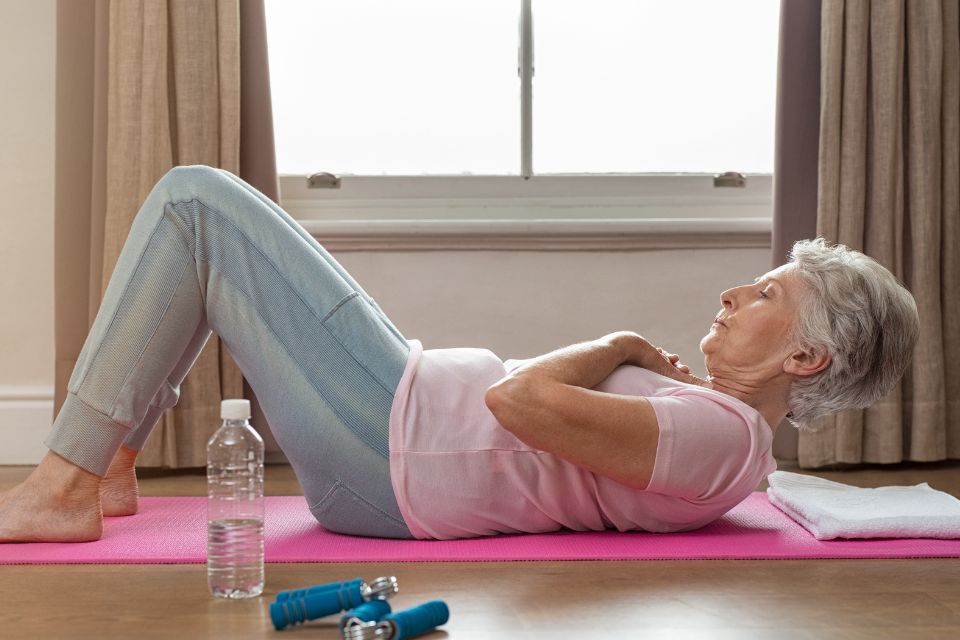
Key Takeaways
- Core strength is crucial for seniors to maintain balance, stability, and independence.
- Targeted exercises can strengthen the core without the risks associated with high-impact movements.
- Engaging in core exercises can lead to improved posture, reduced back pain, and better overall health.
- Seniors should prioritize safety and consider seeking professional guidance when starting a new exercise regimen.
- Incorporating balance challenges into daily routines can enhance the benefits of core strengthening.
Understanding Core Strength
When we talk about core strength, we’re referring to the power center of our body. It’s not just about having a flat belly or being able to do a hundred sit-ups. Core strength is about giving your body the ability to support all of your movements, whether that’s carrying groceries, playing with grandkids, or simply getting up from a chair. It’s the foundation that allows you to live a full, active life without constantly worrying about falls or injuries.
Why Seniors Can’t Ignore Core Training
As we age, our muscles naturally begin to lose some of their strength and elasticity. This is why core training becomes even more important. A strong core is your best defense against the risk of falls, which are a leading cause of injury in seniors. Besides that, a strong core helps with everything from better posture to easing the strain on your back. Think of it as the anchor that keeps your ship steady in choppy waters.
Start with the Basics: Identifying Core Muscles
Before we dive into exercises, let’s get clear on what we mean by ‘core muscles.’ Your core isn’t just your abdominals; it’s a complex series of muscles that includes your pelvic muscles, hips, and the muscles that support your spine. Together, these muscles work in harmony to support your body through all kinds of activities.
The Role of Core Muscles in Daily Activities
Every time you bend to tie your shoes or reach up to grab a can from the shelf, your core muscles are at play. They help you balance and provide the strength needed for these everyday tasks. A strong core means you’re less likely to throw your back out or lose your balance and fall.
Core Muscles: More Than Just Abs
It’s a common misconception that your core is just another word for your abs. In reality, your core extends beyond your abdominal muscles. It includes muscles around your midsection, such as your obliques, as well as muscles around your pelvis and even your glutes. These muscles work together to support your spine and allow you to move in all directions.
Building a Foundation: Core Strengthening Exercises
Now, let’s talk about how to build up that core strength. You won’t need any fancy equipment or a gym membership. What you will need is a bit of space, a comfortable mat, and the willingness to start slow and listen to your body.
Low-Impact Exercises for a Stronger Core
- Seated Belly Breathing: Sit comfortably and focus on drawing your belly in towards your spine as you exhale. Release as you inhale. This simple exercise engages your deep core muscles.
- Bird Dog: On all fours, extend one arm and the opposite leg, hold for a few seconds, and switch. This exercise improves balance and stability.
- Chair Planks: Holding onto the seat of a chair with your hands, step back to form a straight line from head to heels, engaging your core to keep your body stable.
Start with these exercises, and as you get stronger, you can increase the number of repetitions or the duration of each hold. Remember, the goal is progress, not perfection. It’s about getting a little bit stronger each day.
Adaptations and Safety: Core Workouts for Different Fitness Levels
Not every senior has the same level of fitness or mobility, and that’s perfectly okay. The beauty of core exercises is that they can be modified to fit any fitness level. If getting down on the floor isn’t an option, you can perform many core exercises while seated or using a wall for support. The key is to start where you are and gradually build up your strength and confidence.
For those with limited mobility, focus on movements that can be done while sitting, like seated marches or gentle twists. If you’re more advanced, you might try standing exercises that challenge your balance, like single-leg stands or tai chi movements. And always, safety is paramount. Use chairs for support, go at your own pace, and never push into pain.
Stay Balanced: Combating Age with Core Stability
Core stability isn’t just about strength; it’s about control. As we age, our reaction times can slow down, making it harder to catch ourselves if we stumble. By improving our core stability, we can react more quickly and effectively, helping to prevent falls before they happen. This control also allows for more fluid and confident movement, making daily tasks easier and safer.
Why Balance Matters: Core Training as a Key Factor
Balance is crucial for everyday activities and it’s directly linked to your core strength. A strong core supports your body’s ability to maintain equilibrium, whether you’re walking on uneven ground or standing on one foot. By incorporating core training into your routine, you’re not just building muscle; you’re training your body to maintain balance in a dynamic world.
Simple Balance Challenges to Incorporate into Daily Routines
There are plenty of ways to sneak balance challenges into your day-to-day life. Try standing on one foot while brushing your teeth, or practice rising from a seated position without using your hands. These small practices can make a big difference in your overall stability and core strength. Just remember to have a sturdy surface nearby to grab onto if needed.
Living Proof: The Transformative Effects of Core Strength
Let’s talk about the real impact of core strength. I’ve seen seniors go from needing assistance to walk, to confidently strolling through the park, all because they dedicated time to strengthening their core. These aren’t just exercises; they’re a pathway to reclaiming your independence and zest for life.
Real Stories: Seniors Reclaiming Independence through Core Training
Take, for example, a gentleman I know who, after a fall, was afraid to even leave his house. Through gentle, consistent core exercises, he built up his strength and balance. Now, he’s back to enjoying walks with his grandchildren and has even taken up dancing again. His story is a testament to the power of perseverance and the transformative effects of core training.
Measuring Improvement: Qualitative Gains from a Stronger Core
Improvement isn’t always measured in pounds lifted or miles run. Sometimes, it’s the little victories that count the most, like being able to carry your groceries without stopping to rest, or getting up from the floor without help. These qualitative gains are a direct result of a stronger core and are worth celebrating.
Navigating the Core Training Journey Safely
Embarking on a journey to improve your core strength is exciting, but it’s important to navigate this path safely. Listen to your body and understand that some discomfort is normal, but pain is a signal to stop and reassess.
Most importantly, consider consulting with a physical therapist or a certified fitness professional who can tailor a program to your needs and abilities. They can guide you through exercises correctly and help you avoid injury. This is especially important if you have pre-existing health conditions.
When to Seek Professional Guidance
If you’re unsure about how to begin, or if you have a health condition like osteoporosis or a history of heart problems, it’s wise to seek professional guidance. A professional can help you understand your limits and provide modifications to keep you safe while you build strength. They can be your partner in creating a sustainable and beneficial core training regimen.
Listening to the Body: Deciphering Good and Bad Pain
It’s crucial to differentiate between the good pain of muscle growth and the bad pain that can signal injury. Good pain might feel like a mild burn or fatigue in the muscles during exercise, which is normal. Bad pain, on the other hand, is sharp, stabbing, or persists well after you’ve finished your workout. If you experience bad pain, it’s time to stop and seek advice.
Listening to the Body: Deciphering Good and Bad Pain
Understanding the difference between ‘good’ and ‘bad’ pain is essential for seniors as they engage in core strengthening exercises. ‘Good’ pain might feel like a mild burn or fatigue in your muscles during or immediately after a workout. This sensation is typically short-lived and indicates that your muscles are being challenged, which is necessary for growth and strengthening. On the other hand, ‘bad’ pain is sharp, persistent, or causes discomfort that lingers long after the exercise is over. This type of pain could be a sign of injury or overexertion and should not be ignored. If you experience ‘bad’ pain, it’s important to stop the activity that caused it and consult a healthcare provider for guidance.
Frequently Asked Questions (FAQ)
As we delve into core strength for seniors, many questions naturally arise. It’s important to address these to ensure that you can embark on your core strengthening journey with confidence and the right information. Here are some of the most common questions answered.
Can core strength really prevent falls?
Yes, improving core strength can significantly reduce the risk of falls. A strong core enhances balance and stability, which are key factors in preventing falls. As your core becomes stronger, you’ll likely find it easier to maintain your center of gravity and recover balance if you do stumble. This doesn’t just apply to high-risk situations; even simple daily activities like standing up from a chair or walking on an uneven sidewalk can become safer with a stronger core.
At what age should I focus more on building core strength?
It’s never too early or too late to start focusing on core strength. However, as we age, it becomes even more important to maintain a strong core to support overall health and prevent falls. Ideally, incorporating core exercises into your fitness routine should be a lifelong commitment, but it’s especially crucial for individuals over the age of 50 when muscle mass begins to naturally decline.
Are sit-ups safe for people with back issues?
Traditional sit-ups can put undue strain on the lower back and neck, which might not be suitable for people with back issues. However, there are many safe alternatives that can strengthen the core without risking further injury. For example, pelvic tilts and partial crunches can be effective and less stressful on the back. As always, it’s best to consult with a healthcare provider or fitness professional before starting any new exercise, especially if you have a history of back problems.
How often should seniors do core exercises?
Seniors should aim to incorporate core exercises into their routine at least 2-3 times per week. This frequency allows the muscles to recover between sessions while still building strength over time. It’s also beneficial to integrate core-strengthening movements into other daily activities to keep the muscles engaged regularly.
Can improving core strength help with arthritis?
Improving core strength can indeed help with arthritis by reducing the stress on joints, especially in the spine and hips. Strong core muscles can better support your body’s weight and relieve pressure on arthritic joints. Additionally, certain core exercises can increase flexibility and range of motion, which may also alleviate arthritis symptoms. However, it’s important to choose low-impact exercises and work with a professional to avoid aggravating the condition.
As we wrap up, remember that core strength is more than just a fitness goal; it’s a key component of a healthy, independent lifestyle for seniors. By focusing on building and maintaining a strong core, you can enjoy a wide range of activities with greater confidence and less risk of injury. Start small, be consistent, and watch as your core strength becomes the cornerstone of your overall well-being.







Recent Comments